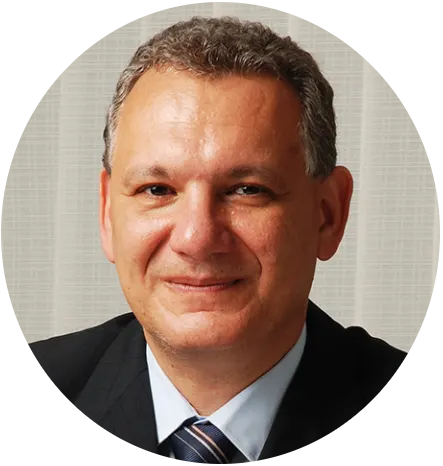
Video Highlight
Guest Profiles

Ricardo Diaz, M.D., Ph.D.
Professor, Infectious Disease Division and head of the Retrovirology Laboratory at Paulista School of Medicine, Federal University of São Paulo, Brazil
Noteworthy: Dr. Ricardo Diaz is a 24-year HIV research veteran with over 200 scientific publications.
Key Insights

Brazil's Proactive Measures Against HIV
Brazil has been at the forefront of combating HIV, implementing proactive measures that have made a significant difference. The country began providing no-cost access to CD4 and viral load testing and antiretroviral drugs as early as 1996. This early intervention and consistent approach led to a remarkable outcome: the number of HIV cases in Brazil was significantly lower than initially predicted.
An article from the New England Journal of Medicine stated that initial estimates predicted Brazil would have 1.2 million people infected with HIV by the year 2000, but with the strategies the country put in place, their actual numbers were about half of what was predicted.
By offering free access to treatments and diagnostic tests, Brazil showcased the importance of early and sustained intervention in managing and reducing the spread of HIV.
The Rising Challenge of HIV Drug Resistance
One of the most pressing challenges in the fight against HIV is the development of drug resistance. Dr. Ricardo Diaz emphasizes that as the HIV virus replicates, it can produce strains resistant to treatment. This resistance threatens the efficacy of antiretroviral drugs, making it crucial to monitor and manage. The World Health Organization reports an increasing rate of HIV drug resistance, underscoring the need for continuous research, monitoring, and adaptation of treatment strategies.
Pre-exposure Prophylaxis (PrEP) Drugs Exist, But Are Not 100% Effective
PrEP, or pre-exposure prophylaxis, is also an antiretroviral drug given to uninfected individuals who are at risk of infection to reduce their chances of acquiring HIV. PrEP is highly effective at preventing HIV when taken as indicated, but much less effective when it isn't taken consistently. Additionally, it's possible to be exposed to HIV strains that are drug resistant while on PrEP, so monitoring resistance in people on PrEP is another important step in prevention.
The Gap in HIV Drug Resistance Testing
Despite the advancements in treatment, there's a noticeable disparity in HIV drug resistance testing, especially in Brazil. Dr. Diaz highlights that while a centralized lab in Brazil performs genotype testing, the number of tests conducted falls short of the actual need. With 10% of patients on treatment showing a viral load above the desired limit, the demand for resistance testing is evident. Bridging this gap and increasing surveillance efforts is essential to tailor treatments effectively and combat the spread of drug-resistant HIV strains.
Episode Highlights

The Importance of Global Health Equity
Dr. Obiageli Okafor sets the stage for the episode, emphasizing the importance of achieving global health equity in HIV treatment. She touches on her personal experiences in providing medical care to those affected by HIV and introduces the focus on Brazil's approach to managing the spread of the HIV virus.
"Today's discussion is really close to my heart because I've had first hand experience providing medical care to people living or affected by the disease we'll be discussing today. So I'm extremely humbled to host today's episode as we dive deeper into an important and timely issue, which is the need to achieve global health equity in the treatment and management of HIV, particularly in low and middle income countries."
Brazil's Success in HIV Management
The episode sheds light on Brazil's progressive measures in combating HIV. By providing access to vital tests and treatments, Brazil has seen fewer HIV cases than anticipated, demonstrating the effectiveness of their strategies.
"Brazil provided access to CD4 and viral load testing and new treatments, including making antiretroviral drugs available for free to people living with HIV beginning as far back as 1996.
The Global Impact of HIV/AIDS
The discussion pivots to the broader global context, highlighting the devastating impact of the HIV/AIDS epidemic. The role of antiretroviral therapy in reducing new infections is emphasized, showcasing the progress made in the fight against the disease.
"The HIV AIDS epidemic remains one of the deadliest global pandemic in the world with an estimated 40.4 million people having died of AIDS-related illnesses since 1981."
The Threat of Rising HIV Drug Resistance
Dr. Diaz dives into the intricacies of HIV drug resistance, explaining how it emerges and why it's a significant threat to treatment efficacy. He underscores the importance of combining drugs to prevent the selection of drug resistance.
"We learn about HIV and some other diseases, that we need to combine drugs, just to prevent the emergence, the selection of drug resistance. Resistance is going to emerge when we are in monotherapy and this happens while patients will not be adherent or fully adherent. Maybe they don't take all the pills, maybe they interrupt treatment and the drugs will have distinct half lives, and at some point there will be a monotherapy. And this is something that really threatens the efficacy of our treatment. And this is something that we need to prevent."
Learn More:
To learn more about HIV molecular testing and drug resistance, please visit our educational resource page at: https://www.thermofisher.com/hiveducation.
To learn about our partnership with Project HOPE to advance health equity among HIV positive youth in Sub-Saharan Africa, click here.
For details on our global commitment to health equity, explore our Corporate Social Responsibility Report: https://www.thermofisher.com/csr

